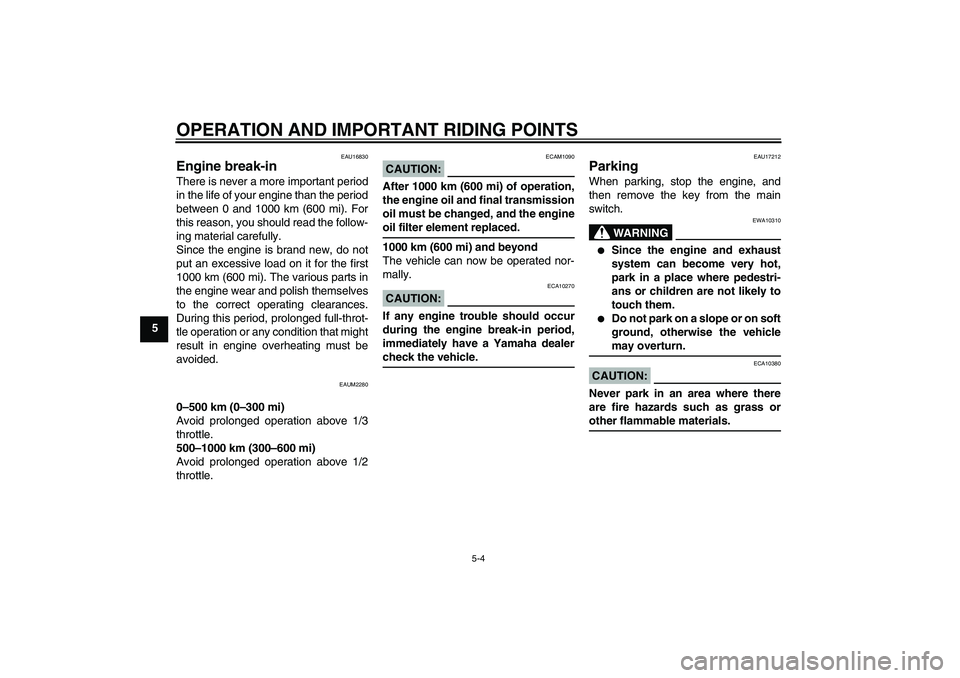Page 20 of 80

INSTRUMENT AND CONTROL FUNCTIONS
3-5
3
EAU12171
Coolant temperature gauge With the key in the “ON” position, the
coolant temperature gauge indicates
the temperature of the coolant. The
coolant temperature varies with chang-
es in the weather and engine load. If
the needle reaches or enters the red
zone, stop the vehicle and let the en-
gine cool. (See page 6-29.)CAUTION:
ECA10020
Do not operate the engine if it isoverheated.
EAUM2250
Multi-function display The multi-function display is equipped
with the following:�
an odometer (which shows the to-
tal distance traveled)
�
two tripmeters (which show the
distance traveled since they were
last set to zero, the time passed
since the tripmeters were set to ze-
ro, and the average speed traveled
during this time)
�
a fuel reserve tripmeter (which
shows the distance traveled since
the fuel level warning light came
on)
�
a clock
�
an ambient temperature display
�
an oil change indicator (which
comes on when the engine oil
should be changed)
NOTE:�
For the UK, the distance traveled
is displayed in miles and the tem-
perature reading is displayed in °F.
�
For other countries, the distance
traveled is displayed in kilometers
and the temperature reading is dis-played in °C.
Odometer and tripmeter modes
Pushing the “MODE” button switches
the display between the odometer
mode “Total” and the tripmeter modes
“Trip” in the following order:
Total → Trip 1 → Trip 2 → Trip/fuel →
Total
1. Red zone
1
ZAUM0639
1.“MODE” button
2. Multi-function display
3.“SET” button
1
2
3
ZAUM0640
U16PE0E0.book Page 5 Tuesday, May 8, 2007 10:26 AM
Page 38 of 80

OPERATION AND IMPORTANT RIDING POINTS
5-4
5
EAU16830
Engine break-in There is never a more important period
in the life of your engine than the period
between 0 and 1000 km (600 mi). For
this reason, you should read the follow-
ing material carefully.
Since the engine is brand new, do not
put an excessive load on it for the first
1000 km (600 mi). The various parts in
the engine wear and polish themselves
to the correct operating clearances.
During this period, prolonged full-throt-
tle operation or any condition that might
result in engine overheating must be
avoided.
EAUM2280
0–500 km (0–300 mi)
Avoid prolonged operation above 1/3
throttle.
500–1000 km (300–600 mi)
Avoid prolonged operation above 1/2
throttle.
CAUTION:
ECAM1090
After 1000 km (600 mi) of operation,
the engine oil and final transmission
oil must be changed, and the engineoil filter element replaced.
1000 km (600 mi) and beyond
The vehicle can now be operated nor-
mally.CAUTION:
ECA10270
If any engine trouble should occur
during the engine break-in period,
immediately have a Yamaha dealercheck the vehicle.
EAU17212
Parking When parking, stop the engine, and
then remove the key from the main
switch.
WARNING
EWA10310
�
Since the engine and exhaust
system can become very hot,
park in a place where pedestri-
ans or children are not likely to
touch them.
�
Do not park on a slope or on soft
ground, otherwise the vehiclemay overturn.
CAUTION:
ECA10380
Never park in an area where there
are fire hazards such as grass orother flammable materials.
U16PE0E0.book Page 4 Tuesday, May 8, 2007 10:26 AM
Page 68 of 80

PERIODIC MAINTENANCE AND MINOR REPAIR
6-30
6Engine overheating
WARNING
EWA10400
�
Do not remove the radiator cap when the engine and radiator are hot. Scalding hot fluid and steam may be
blown out under pressure, which could cause serious injury. Be sure to wait until the engine has cooled.
�
After removing the radiator cap retaining bolt, place a thick rag, like a towel, over the radiator cap, and then
slowly rotate the cap counterclockwise to the detent to allow any residual pressure to escape. When the hissingsound has stopped, press down on the cap while turning it counterclockwise, and then remove the cap.
NOTE:If coolant is not available, tap water can be temporarily used instead, provided that it is changed to the recommended coolantas soon as possible.
Wait until the
engine has cooled.
Check the coolant level in the
reservoir and radiator.
The coolant level
is OK.The coolant level is low.
Check the cooling system
for leakage.
Have a Yamaha dealer checkand repair the cooling system.Add coolant. (See NOTE.)
Start the engine. If the engine overheats again,
have a
Yamaha dealer check
and repair the cooling system.
There is
leakage.
There is
no leakage.
U16PE0E0.book Page 30 Tuesday, May 8, 2007 10:26 AM